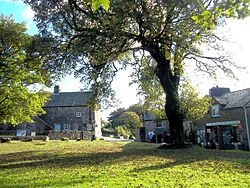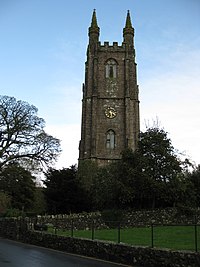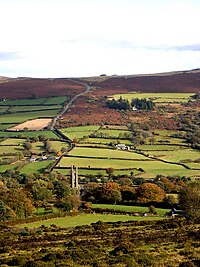Widecombe-in-the-Moor
| Widecombe-in-the-Moor | |
| Devon | |
|---|---|
 Village green | |
| Location | |
| Grid reference: | SX718767 |
| Location: | 50°34’33"N, 3°48’43"W |
| Data | |
| Post town: | Newton Abbot |
| Postcode: | TQ13 |
| Dialling code: | 01364 |
| Local Government | |
| Council: | Teignbridge |
| Parliamentary constituency: |
Teignbridge |
| Website: | Widecombe-in-the-Moor.com |
Widecombe-in-the-Moor is a village on Dartmoor in the heart of Devon. It sits in an open valley, the tall spire of its church visible for miles around
The name ‘Widecombe’ is thought to derive from 'Withy-combe' which means Willow Valley. The village itself has 196 households, but its large, sprawling parish stretches for many miles and encompasses dozens of isolated cottages and moorland farms. The parish is surrounded, clockwise from the north, by the parishes of Manaton, Ilsington, Ashburton, Buckland-in-the-Moor, Holne and Dartmoor Forest.
Tourism is a major source of income for Widecombe today, and within a small area of the village there are several gift shops (including a National Trust shop), two cafés and two pubs (the Old Inn and the Rugglestone).
The village is well known for Widecombe Fair, held annually and celebrated by a folksong of the same name, featuring "Old Uncle Tom Cobley and All". Its words were first published in 1880, and the characters from the song are featured in many of the souvenirs on sale in the local shops. Also popular are the traditional Toby Jugs – a type of mug, with a handle, shaped as a three-dimensional caricature of a person's head – sometimes fictional, sometimes a celebrity.
The church
The church of St Pancras is known as the "Cathedral of the Moors" in recognition of its 120-foot tower and relatively large capacity for such a small village. Originally built in the fourteenth century, in the Perpendicular style (late Gothic), using locally quarried granite, it was enlarged over the following two centuries, partly on the proceeds of local tin mining. Inside, the ceiling is decorated with a large number of decorative roof bosses, including the tinner’s emblem of a circle of three hares (known locally as the Tinners' Rabbits).
The church was badly damaged in the Great Thunderstorm of 1638, apparently struck by ball lightning during an afternoon service. The building was packed with about 300 worshippers, four of whom were killed and around 60 injured: the tale is told on a contemporary memorial board in the church. Local legend relates that the disaster was caused by a visit from the Devil.
About the village
In Widecombe churchyard is the grave of novelist Beatrice Chase who lived for much of her life in a cottage close to the village. Her real name was Olive Katharine Parr, and she claimed to be a direct descendant of William Parr, the brother of Catherine, the sixth wife of Henry VIII.
Next to the church stands the Church House, built in 1537. It is thought to have originally been built as a brewery for the production of church ales, became adapted as an almshouse, and later became the village school. Today, it is used as a meeting place for local people. Sexton's Cottage forms the western end of the building and is now a National Trust shop and Dartmoor National Park information point. It is now managed by the National Trust. Standing in front of the building is a 15-inch naval shell, which was donated to the village after the First World War to thank the villagers for supplying troops with sphagnum moss, which grows in abundance in the damp Dartmoor conditions, and is said to have healing properties. It was used as an emergency field dressing for injured troops.
The size of the parish meant that, for centuries, families were obliged to walk for miles to attend the church every Sunday. The task was even more challenging when it came to burying their dead, whose coffins had to be carried over rough ground and both up and down exceptionally steep hills. Halfway up Dartmeet Hill, for example, lies the Coffin Stone, close to the road, where the body would be placed to allow the bearers to take a rest. The rock is split in two, along its length. The ever imaginative well of local legend has it that the body of a particularly wicked man was laid there, and as he rested the stone was struck by a thunderbolt, destroying the coffin and splitting the stone in two.
The deserted mediæval village of Hutholes and the abandoned farmstead Dinna Clerks (also spelt Dinah Clark's) are nearby.[1] The Rippon Tor Rifle Range lies within five miles of the village.
Outside links
| ("Wikimedia Commons" has material about Widecombe-in-the-Moor) |
- The Widecombe-in-the-Moor.com
- Widecombe in The Dartmoor Archive
- Church House information at the National Trust]
- The Church House, Widecombe-in-the-Moor
References
- ↑ Beresford, Guy. "Three deserted mediæval settlements on Dartmoor". http://ads.ahds.ac.uk/catalogue/adsdata/arch-769-1/ahds/dissemination/pdf/vol32/32_175_183.pdf. Retrieved 2008-07-19.

